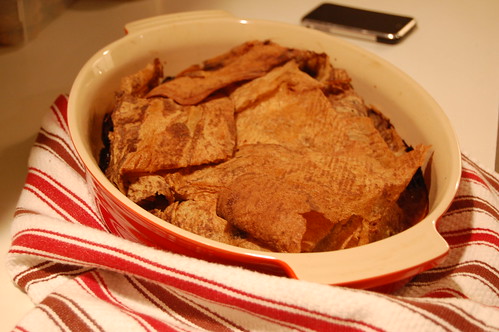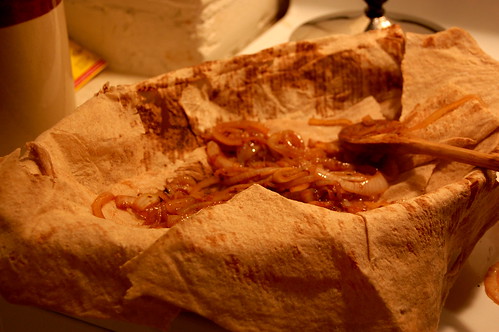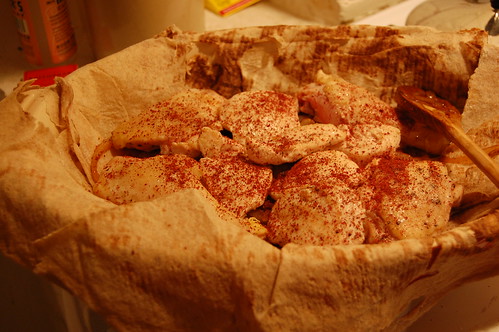 There is a chicken carcass simmering in a pot of water on my stove and my house smells wonderfully of burgeoning chicken stock. But the cause of this smell is something even more excellent and tasty - bread-wrapped roast chicken. This is a Palestinian dish found across the Levant called musakhan. Musakhan, which literally means "warmed," consists of chicken pieces and caramelized onions wrapped up in swaths of of flatbread and baked until the chicken falls off the bone and the bread absorbs all those good chicken juices.
There is a chicken carcass simmering in a pot of water on my stove and my house smells wonderfully of burgeoning chicken stock. But the cause of this smell is something even more excellent and tasty - bread-wrapped roast chicken. This is a Palestinian dish found across the Levant called musakhan. Musakhan, which literally means "warmed," consists of chicken pieces and caramelized onions wrapped up in swaths of of flatbread and baked until the chicken falls off the bone and the bread absorbs all those good chicken juices. You'll see many different versions of this across the Middle East, including fast food versions that include flatbread dough with onions and chicken baked on top. But the traditional version wraps the chicken in a kind of bread called marquq, a very thin flatbread made on a saj grill. A good Middle Eastern grocery will have marquq, but other thin flatbreads, like shraq or lavash will also work.
You'll see many different versions of this across the Middle East, including fast food versions that include flatbread dough with onions and chicken baked on top. But the traditional version wraps the chicken in a kind of bread called marquq, a very thin flatbread made on a saj grill. A good Middle Eastern grocery will have marquq, but other thin flatbreads, like shraq or lavash will also work. When I once described this dish to a friend, she exclaimed, "bread-wrapped roast chicken, that sounds like a dream!" And indeed, it is excellent. The bread, which is soft and full of chickeny juices on the bottom and crisp and crackly no top, the deep flavor of caramelized onions, the fleck of sumac, the tender meat. It's the sort of weeknight comfort food you can eat all week long.
When I once described this dish to a friend, she exclaimed, "bread-wrapped roast chicken, that sounds like a dream!" And indeed, it is excellent. The bread, which is soft and full of chickeny juices on the bottom and crisp and crackly no top, the deep flavor of caramelized onions, the fleck of sumac, the tender meat. It's the sort of weeknight comfort food you can eat all week long.  Musakhan
MusakhanWhile you can include the chicken wings in the pan, I find the wings are boney and take up too much space in the pan, so I usually set them aside from another use. I like to double or triple the bread on the bottom, so that it absorbs chicken and onion juices, but I like only one layer of crispy bread on the top.
1 chicken (about 3 1/2 lbs), butchered into 2 legs, 2 thighs, 2 breasts
good quality olive oil
2 large sweet onions, or 3 medium size ones
1/4 cup sumac
3-4 sheets marquq bread
salt, pepper
1. In a large, wide skillet, heat a small glug of the olive oil, then lightly brown the chicken on all sides over medium heat, removing to a plate as they brown. Remove and set aside. Add some more olive oil to the skillet and cook the onions until translucent, about 35 minutes, stirring occasionally. Add the sumac and cook for 2 minutes to mix.
2. Preheat the oven to 325F. Grease an 8x8 inch baking dish or large casserole, then line with two or three stacked sheets of marquq bread, or two halves of Arabic-style bread. Spoon half the onions over each, then arrange the chicken on top of the onions and cover with the remaining onions and the juices from the casserole. (You want the chicken and onion to be crowded in the pan, this prevents the bread from burning.) Cover with a single sheet of marquq bread or halves of Arabic bread, tucking in the sides crusty side up and sprinkling some water over top. Place into the oven.
3. After the first 20 minutes, cover the dish with aluminum foil. Bake until the chicken is very tender and almost falling off the bone, a total of about 1 1/ 2 hours. Keep an eye on the bottom of the pan, if you see juices bubbling in the bottom of the pan add some water to the bottom of the pan so they don't burn.
3. Let rest a few minutes, then serve. Makes good leftovers.
Note: The size of marquq bread varies, so use common sense.

I see you used Clifford A Wright's recipe for this dish, but you forgot to mention in the ingredients that a half cup of olive oil is needed. Nice photos!
ReplyDeleteRecipe looks lovely - but where might I look to find the bread? I have rarely cooked middle eastern cuisine before and have no idea where to start looking for specific ingredients.
ReplyDeleteI am so lucky to have found the markook in my town of Dallas, texas, so I can experience this too
ReplyDelete!
Wow! It does indeed sound like a dream!
ReplyDeleteThanks for sharing this delicious recipe.What can I substitute for the arabic bread? Would lavash or naan work? I dont think I can find marouq bread by me.
ReplyDeleteThanks
Amy
Thanks for sharing your recipe.. I will surely try this one at home.
ReplyDeleteThis really add on my cookbook.I will surely try this on my birthday.
ReplyDeleteLittle Rock Wedding
Can I give my unsolicited two cents on this? Traditionally in Palestine it is made with thick, pillowy 'taboon' bread. Very similar to Indian naan in texture. I'm craving this now, with extra sumac and a generous heaping of loz and snobar on top!
ReplyDeleteThe version I've made called for boiling the chicken and then it got the lovely brown color when roasting it on the layers. It's a "traditional" version that I learned as the "reheating" happens in part because it's frequently leftover chicken. It's boiled with a little cardamom and salt. The bread is often dipped in the stock before tearing it up and making the layers. Also a great variation instead of pine nuts (which I love) was one that my friends mother made with peanuts. Not sure where she got the idea, but it was a surprising and yummy substitution.
ReplyDeleteAnd btw, I'm in love with your blog-- only recently discovered it. And am currently trying your braided wreaths. I couldn't resist.
I made a "Desert Candy" dinner. Few may think that my choices were correct compliments to each other but nothing was left in the pan
ReplyDeleteSoup
Musakhan, with Mashed Carrot Salad
Alfajores
Thank you for the inspirations
I'm eager to try this recipe, but there is nothing resembling a Middle-Eastern grocery anywhere near my house, and I don't think I'll ever find marquq. I did find, however, that Alton Brown has a recipe for lavash (which you mention can be used in lieu of the marquq), but it seems to yield a product more closely resembling crackers and I wonder if his lavash can be successfully substituted here. What do you think?
ReplyDeleteBeautiful photos of this delicious dish! thanks for sharing your recipe.
ReplyDeleteWhat possible motivation was there for not crediting the source of this recipe? Very odd and poor form. This is a Clifford Wright recipe which he credits to his former mother-in-law Leila al-Qattan.
ReplyDeleteHere it is.
http://www.cliffordawright.com/caw/recipes/display/recipe_id/804/
NFA -- You are correct that the portions in the recipe are the same as Wright's, however you will note that several steps in the recipe are quite different (temperature, pan size, covering technique). I should have given Wright credit for the inspiration but this post in nearly 5 years old, so I can't remember why I didn't, perhaps I forgot. I respect Wright's work immensely and as you can see from other posts on this blog I always give credit for the recipe's of others. I will be sure to remedy it in the post.
ReplyDeleteLifexhistory -- Thanks for the bread dipping tip! I actually don't love this recipe for musakhan because I feel like the bread is too thin and dries out too much. Perhaps I will try your tips and Dalia's tip about taboun bread and try a new version.
Dalia -- advice is always welcome :) !!